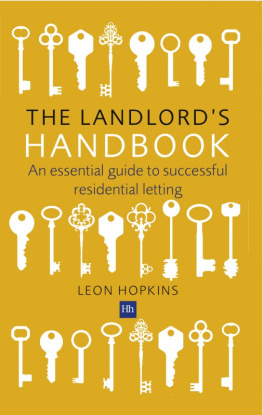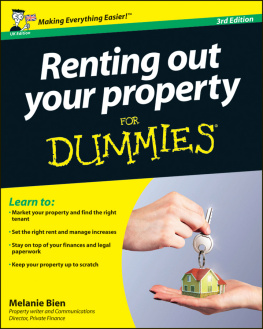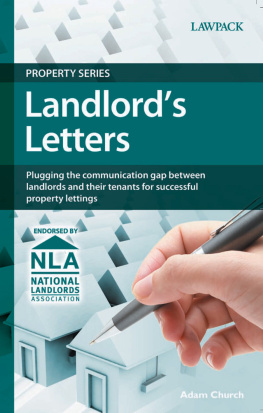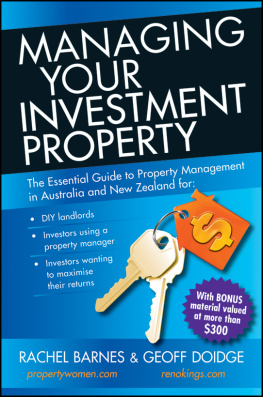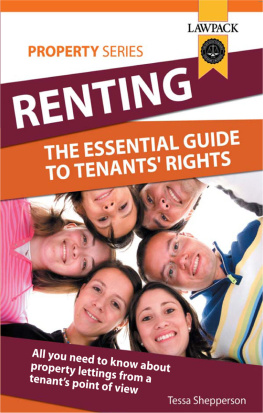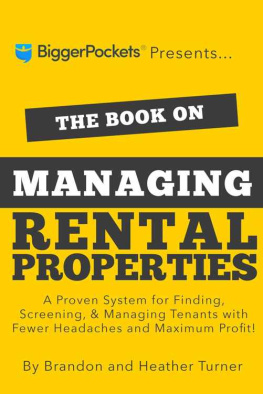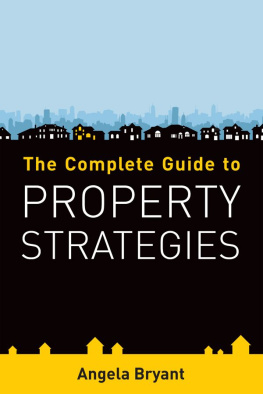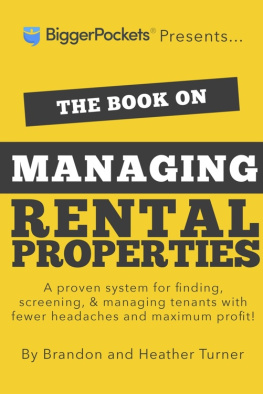Acknowledgments
Special thanks to Marcia Stewart, Ilona Bray, and Ann OConnell for stellar editing and helping make this book a readable reality.
This book is dedicated to small-time landlords everywhere, the men and women who roll up their sleeves to make a big-time difference through housing others.
About the Author
Michael Boyer is a part-time landlord, college professor, and attorney. He has graduate degrees in management and law, plus over a decade of experience as a successful do-it-yourself landlord. He has been on both sides of the landlord-tenant equation, as a landlord and as a volunteer attorney representing low-income tenants. Boyer is the author of numerous articles and chapters, and has served on many boards, including several condominium association boards. This is his first book and it is a culmination of years of collecting notes, tips, and day-to-day observations about what practices really work for the small-time landlord (especially one with a day job).
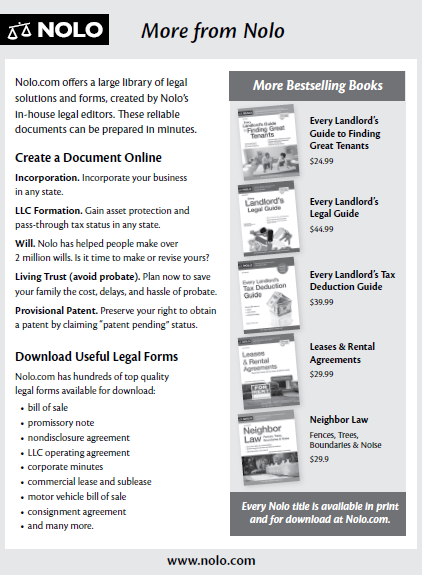
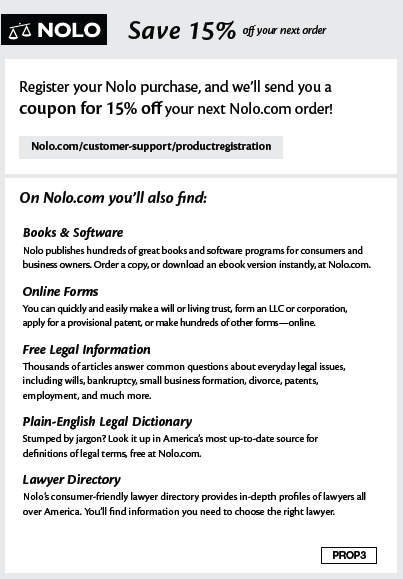
CHAPTER
Whats Your Competitive Edge?
Whether you are beginning, continuing, or expanding your rental property business, your chances of success and longevity as a landlord can be greatly improved by crafting a strategy that will give your units an edge over the competition. And make no mistake, there will be competition. Potential renters compare units based on price, location, condition, size, amenities, terms, and a host of other factors.
You need a focus, a plan, and a strategy to make sure people choose your rental unit over others. You might not need a highly complicated planin fact, crafting a competitive advantage can be surprisingly simple for the small-time landlord. First, get to know your marketthe competition as well as the customers. Then, devise ways that your rentals, and your approach to property management, can stand out to potential tenants.
A major allure to being a small-time landlord is that you can compete, and even offer a superior product and better service than a large billion-dollar property firm, simply by putting in extra effort and doing small but meaningful things. There are two primary ways to beat the competition.
First, be different. Offer something other rentals on the market dont; you can differentiate, for example, by allowing a different lease term (like six months), allowing pets, or even offering better management and communication; all three are covered throughout the book. Also, choosing attractive features in the rental properties you own (like a yard or garage) can help differentiate, as can a more convenient location (all covered in on selecting properties).
Second, be cheaper. Offer a comparable unit for less than the others on the market, which you may be able to do with low overhead and by reducing turnover.
The key is to employ one (or both) strategies; otherwise, you are offering the same thing at the same price as your competitors (and dont have an advantage). Dont leave it to chance: have a strategy to offer the price and unique terms or features, so the best renters call you first.
Get to Know Your Market and Where Your Rental Fits Within It
You can never know enough about your rental market. After a few years of owning and managing rental property, you should be very knowledgeable about the price points, terms, needs, demographics, and demands for rental housing in your area. Read Craigslist and other rental ads constantly. View the photos. Drive by the competition. Look for subtle clues beyond price and size. For example, what is included in the rents charged? Do the units have their own washers and dryers? Do they provide adequate parking spaces? Do they allow pets? Are the terms flexible?
Doing your homework can help you craft your own pricing and marketing strategy. The good news is that everyone needs a place to live, and in many markets around the country, the demand for quality, affordable rentals outstrips supply. (Of course, different areas have different vacancy rates.) After educating yourself about your local rental market, think about your price (or rental amount), property type, and how you will promote it to grow your business according to your own needs and goalsfor example:
If your target market is college students in a college town, youll be adding different amenities than if youre trying to attract families with children in a suburban community.
Your strategies will differ if you own rentals in a super-competitive market with a high vacancy rate versus a community with a low vacancy rate and large tenant population.
If you rent out a duplex in an area where income levels are low and unemployment high, youll want to take a completely different approach than you would if renting a high-end condo in an affluent community.
Differentiate Your Units From the Competition
A key part of your success will be a differentiation strategy. Think about practical and meaningful ways you can make your rental unitseven when similar to competitorsmore appealing to your target renters. This means you wont simply offer the exact same product at the same price as your competitors. (If you want to try that approach, you really will be relying on luckhoping tenants happen to call and sign with you first.) This does not necessarily mean you have to add expensive amenities or commit to providing extra services.
Here are some simple ways to set your rentals apart from the competition, the details of which Ill discuss in subsequent chapters of this book.
Pets on Approval
Almost half of all Americans have a dog and around a third have a cat, yet many rentals flat-out prohibit pets. With these facts in mind, takes a detailed look at a pets on approval policy that will open up your rentals to sensible, responsible pet owners with well-behaved pets. This policy can minimize the risk of pet problems (noise, smells, damage) while maximizing your chances of getting great tenants. Your rental will automatically outcompete other units where landlords have a strict no-pets-allowed policy. Better yet, many tenants will base their decision to rent on this factor alone.
Top-Notch, Personal Service
Small-time landlords can offer big-time service. Right away, you will likely know the tenants name, needs, and preferences. Instead of tenant in unit 179, your tenant will be Jake or Jane. You can demonstrate this from the get-go by having the unit ready in pristine condition and arriving early and staying late to show the place to prospective tenants. You will study the applicants into the wee hours to try to find the best fit. Your response time to communications and requests should also be outstanding.
Other landlords and property managers might have dozens, even hundreds, of units to manage. They will do the job well enough to earn a fee and stay employed. Such a manager is not really incentivized to do more. If youre managing just a handful of properties, you should be able to easily best them on the service level.
Youll notice that some prospective tenants will be surprised to see the owner there, on site showing the place, rather than a proxy. Theyre used to dealing with hired managers who have neither the same incentive nor the power to be flexible. They can sense right away that you are


